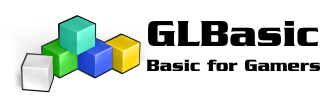Hi all, I have a question. I want to have a bullet follow a path from a start position to a goal position in a certain nr of steps. And when it reaches the goal position, it should do a hit check etc. But I can't get the compare of 2 floating point values to work. Here is an example code.
So the code does the following:
1) divide length of path into 60 steps
2) increment start position with steps of divided length
3) check if goal position is reached
The check if x=xGoal and y=yGoal is almost never true (on rare occasions it is). I guess this is due to limited precision of floating points, causing the end result to being slightly off. For example the goal position is (123, 456) but the incremented result is (123.0003, 456.0001) or something like that. So I think you will run into the same problem when working with C or Java etc. not just GLBasic.
But it's strange because the debug output is for example this
Positions are NOT equal. x=116 y=34 <> xGoal=116 yGoal=34
I can add an iSteps variable and simply count the nr of steps. But my question is, what is the best way to check if the goal is reached using float variables?
Code (glbasic) Select
SEEDRND GETTIMERALL()
WHILE (KEY(0) = FALSE)
DEBUG " -- start test --\n"
Test()
WEND
FUNCTION Test:
// variables
LOCAL iStep%, iCount%
LOCAL x#, y#, xGoal#, yGoal#, xSpeed#, ySpeed#
// start at bottom of screen
x = 320
y = 480
// goal is random position at top of screen
xGoal = RND(640)
yGoal = RND(100)
// set speed so that block moves from start to end in exactly 60 steps
xSpeed = (xGoal - x) / 60.0
ySpeed = (yGoal - y) / 60.0
// do the steps
iCount = 0
WHILE (iCount < 100)
// draw block and goal
DRAWRECT xGoal, yGoal, 4, 4, RGB(192, 255, 0)
DRAWRECT x, y, 8, 8, RGB(0, 192, 255)
SHOWSCREEN
// update all
x = x + xSpeed
y = y + ySpeed
IF (x = xGoal) AND (y = yGoal)
DEBUG "GOAL REACHED!\n"
ELSE
// goal not reached, check if close to goal
IF (ABS(x - xGoal) < 10) AND (ABS(y - yGoal) < 10)
DEBUG "Positions are NOT equal. x=" + x + " y=" + y + " <> xGoal=" + xGoal + " yGoal=" + yGoal + "\n"
ENDIF
ENDIF
iCount = iCount + 1 // to stop WHILE loop
WEND
ENDFUNCTION
So the code does the following:
1) divide length of path into 60 steps
2) increment start position with steps of divided length
3) check if goal position is reached
The check if x=xGoal and y=yGoal is almost never true (on rare occasions it is). I guess this is due to limited precision of floating points, causing the end result to being slightly off. For example the goal position is (123, 456) but the incremented result is (123.0003, 456.0001) or something like that. So I think you will run into the same problem when working with C or Java etc. not just GLBasic.
But it's strange because the debug output is for example this
Positions are NOT equal. x=116 y=34 <> xGoal=116 yGoal=34
I can add an iSteps variable and simply count the nr of steps. But my question is, what is the best way to check if the goal is reached using float variables?

 But working via e-mail/chat, never meeting face-to-face seems kind of weird to me. Also, what would be an estimated price range for, let's say, three A4-size drawing/illustrations with or without color?
But working via e-mail/chat, never meeting face-to-face seems kind of weird to me. Also, what would be an estimated price range for, let's say, three A4-size drawing/illustrations with or without color? I have a question about array of types, and assignment of these array elements.
I have a question about array of types, and assignment of these array elements. )
)
 (see attachment)
(see attachment) I tried the Quantum game and looked at the code, and it runs great. I especially like the built in net-support for online highscore tables, and with only a few lines of code.
I tried the Quantum game and looked at the code, and it runs great. I especially like the built in net-support for online highscore tables, and with only a few lines of code.